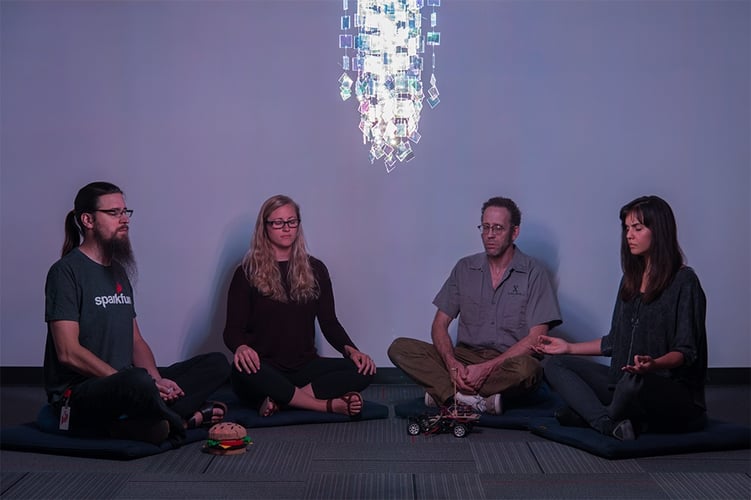In addition to my fun job at SparkFun, I am quite the meditation geekstra and teach meditation locally. I hear often from many of my students that they feel more creative and focused once they start meditating. So, I’m here to share some simple steps for meditating that can help you (and your students) experience the technique and results for yourselves.
Whosoever lasts the longest gets that burger!
Benefits of Meditation
Meditating is all the buzz out there right now — for good reason. Research over the past 20 years shows us that meditation offers many health benefits to the body and mind. Scientists have found that it can help relieve stress, lower blood pressure and significantly lower the risk of heart disease. It also can help strengthen the immune system, improve mental health and even slow the aging process.
Meditation in the Workplace
More and more, U.S. companies are offering meditation programs for their employees. Probably not surprisingly, Apple leads the way. Steve Jobs took part in meditation retreats and was married in a Zen ceremony. Apple allows employees to spend 30 minutes a day meditating and provides classes on meditation.
Nike is also onboard, providing its employees access to relaxation rooms and a mindfulness and meditation coach during the workday. Never one to be left off a list of workplace perks, Google is also known for its meditation programs. Google’s “Search Inside Yourself” program is even marketed to other companies throughout the world looking to encourage creative thinking. Another early adopter of meditation in the workplace was the Walt Disney Company. After Disney employees meditated on creative solutions, they were found to experience a dramatic spike in creativity. The list goes on and on.
Mindfulness Meditation
Meditation is increasingly recommended for everything from relaxation, health and relationship enrichment to sports and business performance enhancement. Drawing on modern science, as well as ancient Eastern traditions and some of my own experience, I want to offer you some easy steps to get started with a popular technique, Mindfulness Meditation, to try out and experience the benefits firsthand.
Mindfulness Meditation is an alert yet passive style of meditation in which we simply pay attention to our breathing, our body, our emotions and our thoughts. Mindfulness is passive in that it does not cultivate conscious thinking and instead involves the self-regulation of attention toward moment-to-moment experiences.
Steps to Meditation
Step 1: Space
Find a quiet space where you will not be disturbed. I like to light a candle or two and maybe some incense.
Step 2: Posture
Get comfortable. Many people think that it’s best to sit cross-legged on the floor; however, this is not a requirement. This posture is traditionally used for spiritually focused meditation, but does not suit many untrained modern Western bodies. In my beginner meditation classes, I recommend sitting on the floor on a cushion, sitting on a chair or even lying down.
When sitting on a cushion, try to sit high enough that your hips are higher than your knees. If sitting in a chair, a simple upright chair with a back for support, with or without armrests, works well. Your hands can rest comfortably on your thighs, or on the arms of the chair. If lying down, it is best to lie on your back, legs a little apart, feet falling naturally outward. Keep your arms straight by your sides and, if possible, the palms of the hands turned upward.
Whichever position you choose, it is important to sit or lie in an upright, open posture. Imagine a mountain: tall, still, majestic. You are doing something important, something significant. Be like a mountain.
For beginner meditators, it is often most effective to close the eyes.
Step 3: Relaxation
Take a few minutes and contract and relax the muscles in your body. Start with the feet, and move up through the calves, thighs, buttocks, tummy, chest, arms, shoulders, jaw, eyes and, finally, the forehead. Simply stiffen each of those areas and release. Notice how it feels in each particular area, contract the muscles and hold them long enough to notice the feeling that the tightening of the muscles creates. Slowly relax the muscles, noticing the feeling of tension releasing and the relaxation that follows. Now, notice how the area feels. As you move through the body, you should begin to feel more relaxed.
Step 4: Mindfulness
Now, take a moment to adjust your position. Gently close your eyes and settle into your body. Take a few long, deep breaths, holding each one briefly after the intake and release.
Now pay attention to any sounds outside the room, just listening with a gentle curiosity, letting the sounds come and go without attributing them to things. Notice your own breathing — be aware that you are breathing in, and then be aware that you are breathing out. Just noticing.
Now see if you can notice any sensations that are there as you breathe in and as you breathe out. Feel the air touch your nostrils, the slight movement of your chest and stomach. Listen to the gentle sounds of your own breathing. Allow your breath to take up whatever rhythm feels natural for you at the moment.
If you notice your attention wandering or becoming distracted, simply bring your attention back to the next breath — being aware of this breath, the next breath and the next. Thoughts are OK. Simply notice them and do not judge them.
Congratulations! You are now meditating!
Using Meditation to Find Creative Solutions
Meditation can be a great way to encourage creative thinking. By freeing the mind from daily concerns, we are able to reach a deeper level of thought that allows us to find solutions we may not have considered otherwise. When students get stuck on a problem, encourage them to take a few minutes to clear their minds through meditation, using these techniques. You never know what they’ll come up with!
Also, there are some great apps to try. I would recommend Calm and Headspace. There's also a Headspace for Kids app that could help younger students be more focused and creative. And here at SparkFun, creating is what it's all about!
Enjoy the journey, and please share any experience you've had using meditation with your students in the comments below!



teaching tools